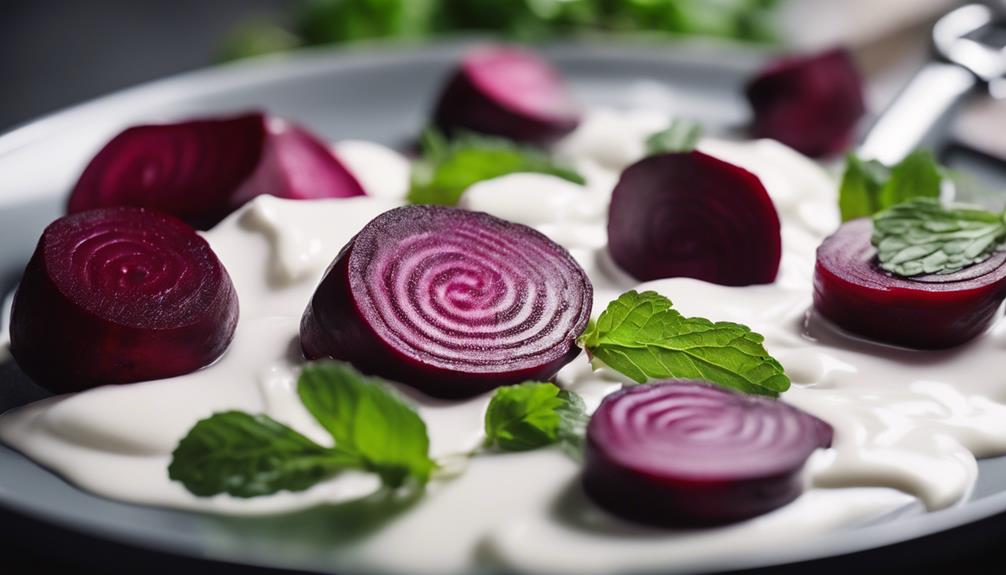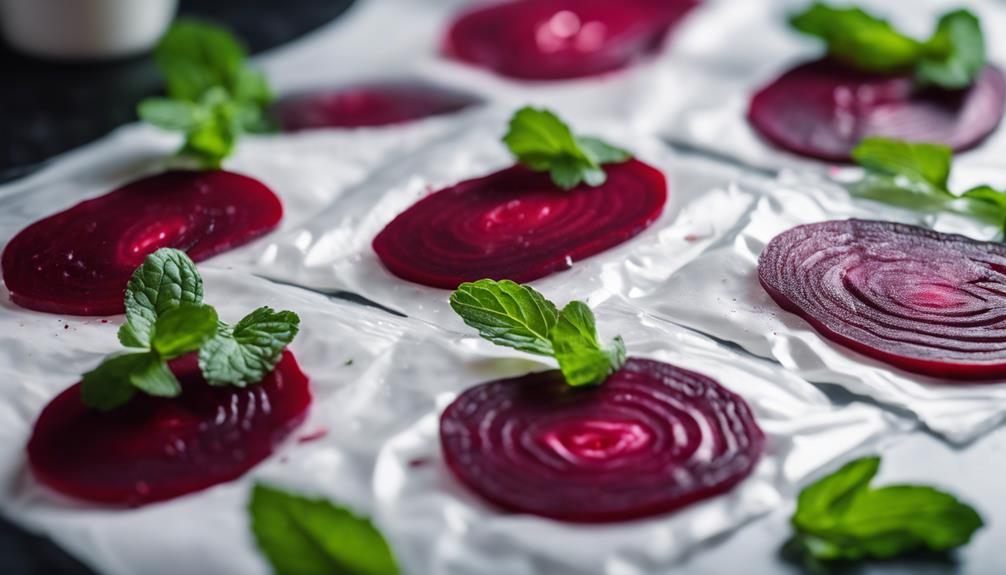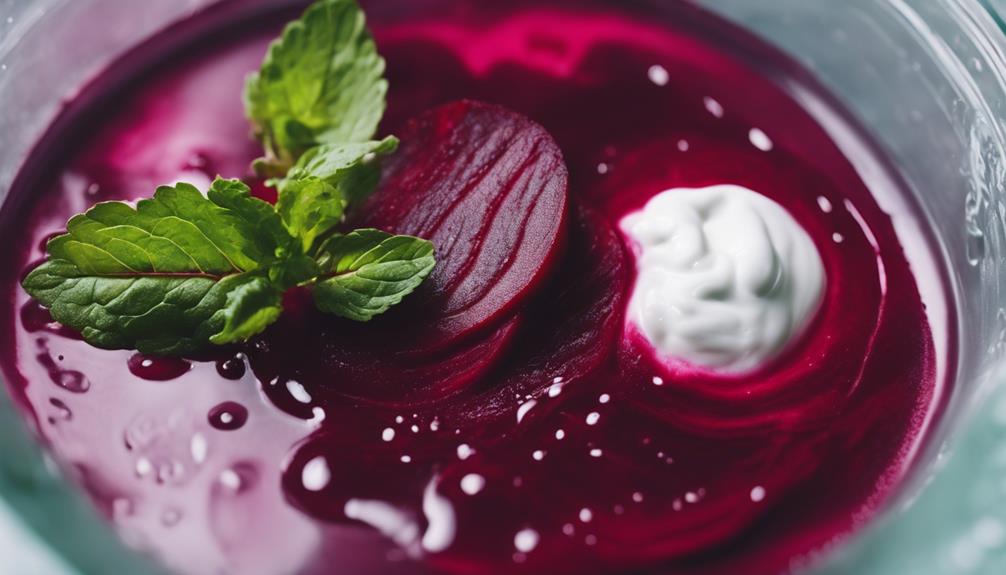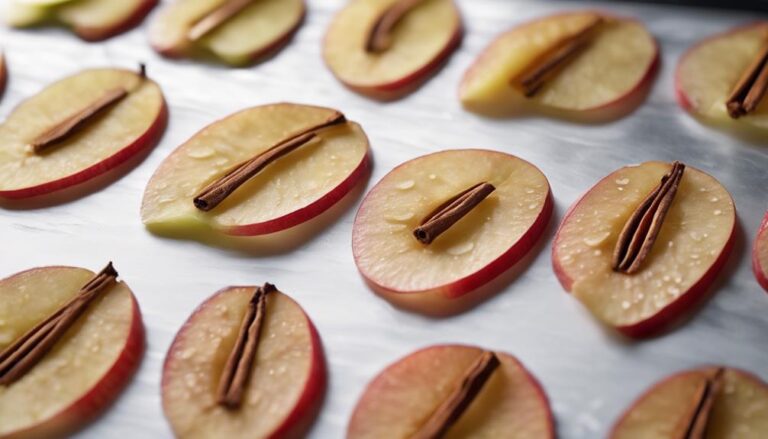Sous Vide Beetroot With Mint Yogurt for Pitta Cooling
Incorporate Sous Vide Beetroot with Mint Yogurt into your diet for a cooling effect on the Pitta dosha. Beetroot, rich in nutrients like folate and antioxidants, helps balance your body. This dish, enhanced with ingredients like balsamic vinegar and mint, creates a revitalizing flavor experience. The sous vide cooking method preserves nutrients and intensifies beetroot's natural sweetness. Try this culinary blend to discover a harmonious and invigorating way to nourish your body and tantalize your taste buds. Uncover the secrets behind this cooling and nutrient-rich recipe for a delightful culinary experience.
What You Will Learn Here
- Beetroot's cooling properties balance Pitta dosha in Ayurveda.
- Mint yogurt enhances cooling effect and adds refreshing taste.
- Sous vide cooking preserves nutrients and natural sweetness of beetroot.
- Combination of ingredients like balsamic vinegar and horseradish complements flavors.
- Incorporating Pul biber pepper adds a hint of spice for balance.
Beetroot's Ancient Origins

Beetroot, cultivated for millennia, has its origins rooted in the Mediterranean region. Ancient civilizations, such as the Egyptians and Romans, recognized the medicinal and culinary value of this vibrant root vegetable.
The antioxidant-rich betalains in beetroot contribute to its historical reputation for promoting blood circulation and stamina.
Beetroot's Historical Significance
Having been cultivated for over 4,000 years, evidence of beetroot consumption dates back to ancient civilizations like Egypt and Mesopotamia. Ancient Greeks and Romans utilized beetroot not only as a food source but also for its purported medicinal properties, believed to cleanse the blood.
The rich red hue of beetroot was highly prized in antiquity for its dyeing capabilities and use in coloring food, underscoring its historical significance. Throughout the Middle Ages, beetroot gained popularity across Europe, featuring prominently in dishes like borscht and as a natural sweetener.
Its nutritional value, including high antioxidant and vitamin content, has been acknowledged since ancient times, further emphasizing its historical importance in various cultures.
Traditional Uses of Beets
Ancient civilizations, such as Egypt and Mesopotamia, utilized beets for both medicinal and culinary purposes, showcasing the rich historical origins of beetroot's traditional uses.
Beetroots were valued for their multifaceted benefits, being employed to address various health issues like constipation and skin conditions. Additionally, in traditional Chinese medicine, beets were recognized for their cooling properties, aligning with Ayurvedic practices to balance Pitta dosha.
The vibrant red hue of beets, attributed to betalains, not only adds visual appeal but also brings along antioxidant and anti-inflammatory qualities. Romans cherished beets for their health advantages and utilized them as natural dyes for textiles and cosmetics.
Integrating beets into ancient practices highlights the enduring significance of this root vegetable through the ages, often paired with ingredients like fresh mint leaves for added depth of flavor and nutrition.
Cooling Properties of Beets
The cultivation of beets traces back over 4,000 years to the Mediterranean region. Ancient Greeks and Romans recognized beets for their medicinal and culinary benefits. Valued for their cooling properties, beets were used to balance the body's Pitta dosha in Ayurvedic medicine. The high water content and earthy nature of beets make them ideal for cooling Pitta imbalances. Incorporating beets in dishes like Sous Vide Beetroot with Mint Yogurt can help cool Pitta and promote balance. Fresh mint, often paired with beets, enhances the invigorating effect.
| Cooling Properties of Beets | Benefits |
|---|---|
| High water content | Hydrating |
| Earthy nature | Balancing |
| Pitta dosha balancer | Cooling |
| Versatile ingredient | Nutritious |
| Complements well with mint | Invigorating |
Beetroot's Nutrient-Rich Components

Rich in essential nutrients such as folate, potassium, and fiber, beetroot offers a valuable array of health-promoting components. Here are three key aspects of beetroot's nutrient-rich profile:
- Antioxidants: Beetroot contains betalains, which are potent antioxidants known for their anti-inflammatory properties. These compounds help combat oxidative stress in the body, reducing the risk of chronic diseases and supporting overall health.
- Nitric Oxide: Beetroot is a good source of nitric oxide, a molecule that plays an important role in vasodilation, which may improve blood flow and enhance athletic performance. By increasing circulation, nitric oxide helps deliver oxygen and nutrients to muscles more efficiently.
- Phytonutrients: The vibrant color of beetroots is a result of phytonutrients such as betacyanin, which have been linked to various health benefits. These compounds contribute to the vegetable's antioxidant properties and may help protect against certain diseases when consumed regularly.
Incorporating beetroot into your diet can provide a range of essential nutrients that support your well-being.
Beetroot Mint Dip Recipe
The Minty Beetroot Yogurt Dip combines the fresh flavors of mint with the earthy sweetness of beetroots, offering a cooling and nutrient-rich addition to your meals.
Horseradish-infused Beetroot Recipe provides a zesty twist to the traditional beetroot dip, while the Pul Biber Pepper Infusion adds a hint of spiciness for those who enjoy a kick in their dips.
Incorporating these variations into your diet can introduce a range of flavors that complement each other while providing a burst of antioxidants and soothing properties.
Minty Beetroot Yogurt Dip
Enhancing the yogurt base with the vibrant hues of beetroot and the fresh essence of mint yields a revitalizing and nutrient-packed Minty Beetroot Yogurt Dip.
- Nutrient-Packed: Beetroot is rich in essential nutrients like folate, manganese, and potassium, adding a nutritional boost to the dip.
- Invigorating and Cooling: The combination of yogurt and mint provides an invigorating and cooling effect, perfect for hot summer days.
- Unique Flavor Profile: The chopped mint complements the earthy sweetness of beetroot, creating a unique and delicious flavor profile in the yogurt dip.
This quick and easy recipe not only offers a visually appealing dip but also serves as a healthy snack option for gatherings or a rejuvenating treat on warm days.
Horseradish-infused Beetroot Recipe
Transitioning from the Minty Beetroot Yogurt Dip, explore the horseradish-infused Beetroot Recipe for a zesty and invigorating twist on this vibrant dish. This fresh dip combines the earthy sweetness of beets with the subtle heat of horseradish, creating a flavorful and rejuvenating combination.
Here are three key aspects that make this recipe stand out:
- Bold Flavor Fusion: The horseradish adds a kick to the beetroot, elevating the taste profile.
- Pitta Cooling Properties: Balancing flavors with a hint of mint, this dip helps cool the body and soothe the senses.
- Versatile Serving Option: Perfect as a healthy snack or appetizer, the horseradish-infused beetroot recipe offers a vibrant and nutritious choice for any occasion.
Pul Biber Pepper Infusion
To infuse the Beetroot Mint Dip with a subtle fruity undertone, consider incorporating the Pul Biber pepper for a nuanced flavor profile. Here's how to achieve this:
- Unique Flavor Enhancement: Pul Biber pepper, with its fruity notes, complements the earthy sweetness of beetroot, creating a harmonious blend of flavors.
- Balanced Minty Invigoration: The addition of mint in the dip provides a cooling and invigorating element that pairs exceptionally well with the slight heat from the Pul Biber pepper.
- Complex Taste Sensation: The combination of mint, Pul Biber pepper, and beetroot offers a multi-dimensional taste experience, appealing to those seeking a sophisticated and flavorful dish.
Enhancing Beetroot's Flavor Profile
When considering enhancing beetroot's flavor profile, factors such as the choice of flavor-enhancing ingredients, the impact of the cooking technique used, and the benefits of incorporating mint play vital roles.
Selecting complementary ingredients can elevate the earthy notes of beetroot, while the sous vide method can enhance its natural sweetness. Additionally, mint's invigorating qualities can provide a contrast that adds depth and complexity to the overall flavor profile of the dish.
Flavor-Enhancing Ingredients
Enhance the flavor profile of beetroot by incorporating a combination of balsamic vinegar, horseradish, Pul biber pepper, and mint yogurt to create a revitalizing and complex taste experience.
Balsamic vinegar's tangy sweetness complements the earthy notes of beetroot, while horseradish adds a fiery kick that cuts through the richness.
Pul biber pepper brings a subtle heat that enhances the overall flavor profile without overpowering the dish.
Mint yogurt provides an invigorating contrast, balancing the dish's flavors.
Olive oil, used in moderation, enriches the beetroot's natural sweetness and helps harmonize the acidity of the yogurt.
This combination of ingredients creates a well-rounded and sophisticated flavor profile that elevates the humble beetroot to a gourmet delight.
Cooking Technique Impact
The sous vide cooking technique precisely enhances the natural sweetness and earthy flavor of beetroots, ensuring ideal texture retention and nutrient preservation. By vacuum-sealing the beetroots and cooking them at a controlled low temperature for an extended period, the sous vide method allows for even cooking throughout, resulting in a consistently tender and flavorful outcome.
This slow cooking process also gives the earthy flavor of the beetroots time to develop and intensify, creating a more robust taste profile. Additionally, the gentle nature of sous vide cooking helps the beetroots maintain their nutrients, as there's minimal leaching of vitamins and minerals into the cooking liquid.
Benefits of Mint
Mint's cooling properties and aromatic compounds synergistically enhance the flavor profile of beetroot dishes, imparting a revitalizing and invigorating element. Mint leaves contain antioxidants, essential oils, and menthol, which not only contribute to overall health but also provide a rejuvenating taste to dishes. Utilizing mint in recipes like beetroot raita adds a touch of vitality and vibrancy, elevating the dish's overall appeal. The versatility of mint allows for its application in various culinary creations, both sweet and savory, enhancing the taste and aroma. Incorporating mint into your cooking not only balances the heat in spicy dishes but also aids in digestion, making it a valuable herb for improving the dining experience.
| Benefits of Mint | |
|---|---|
| Cooling properties | Antioxidants |
| Aromatic compounds | Essential oils |
| Versatility | Revitalizing flavor |
Final Thoughts
In concluding, the Sous Vide Beetroot with Mint Yogurt offers a revitalizing and nutritious addition to your culinary repertoire, with a harmonious blend of flavors and textures.
The earthly flavor of the beets, combined with the invigorating mint yogurt, creates a balanced dish that isn't only pleasing to the palate but also rich in essential nutrients. The sous vide cooking method employed guarantees that the beetroot retains its natural goodness, making it a wholesome choice for a cooling meal.
The addition of balsamic vinegar, horseradish, and Pul biber pepper further enhances the taste profile, adding depth and complexity to each bite. Cooking the beetroot in a water bath at 90 degrees for 1 hour results in a tender and flavorful outcome that's sure to satisfy.
To elevate the dining experience, consider serving this dish with a side of salad leaves and a sprinkle of sea salt, adding a touch of freshness and enhancing the overall enjoyment of the meal.
Frequently Asked Questions
How Long Does Beetroot Take to Cool?
Beetroot benefits from properly cooling after cooking, taking about 1 hour sous vide at 90 degrees. This method retains nutrients and flavors. For best results, guarantee precise cooling. It's crucial to maintain texture and taste before serving.
How Long Does It Take to Sous Vide Beets?
Sous vide variations require precise temperature control for best results. Beets typically cook for 1 hour at 90 degrees Celsius, ensuring even cooking and nutrient retention. This method allows for consistent textures and flavor infusion possibilities.
What Are the Benefits of Beetroot and Mint Juice?
Beetroot and mint juice offer a potent mix of antioxidants, aiding in inflammation reduction, detoxification, and cardiovascular support. This blend rich in iron, potassium, and vitamin C, boosts energy levels, enhances exercise performance, and promotes digestion.
Is It Better to Boil or Steam Beetroot?
When considering roasting vs boiling beetroot, opt for roasting to intensify flavor and retain nutrients. Roasting guarantees better texture and flavor modulation compared to boiling, making it a superior choice for enhancing the overall beetroot experience.
Conclusion
To sum up, the sous vide beetroot with mint yogurt recipe offers a revitalizing and nutritious option for cooling pitta.
By combining the ancient origins and nutrient-rich components of beetroot with the fresh and aromatic flavors of mint yogurt, this dish provides a well-rounded culinary experience.
Enhancing the flavor profile with subtle seasonings and precise cooking techniques further elevates the dish, making it a satisfying and healthful choice for those seeking a balance of taste and nutrition.











